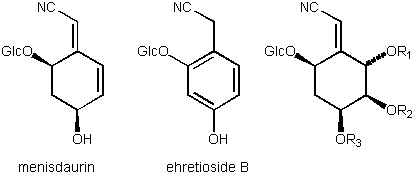
| Ś¤‹†‚Ě•Ĺ (Japanese) | ||
| Return to "Research" |
Most of the cyanoglycosides in Nature are cyanogenic, since they have a nitrile group alpha to the glycosidic linkage. Hydrolysis of these cyanogenic glycosides by certain glycosidase, followed by oxidation of the resulting cyanohydrin liberates the corresponding aldehyde or ketone and HCN. The liberated HCN is responsible for their physiological activity including toxicity.
However, there is a small group of cyanoglycosides having a nitrile group which is not adjacent to the glycosidic linkage. Several examples of these glycosides isolated from plants are shown and their structure elucidation, occurrence, biogenesis, biological activity and promising application will be discussed.

| R1 | R 2 | R3 | |
| simmondsin | H | Me | Me |
| lophoriside A1 | H | Bz | Bz |
| lophoriside A2 | Bz | H | Bz |
| lophoriside B1 | H | Cin | Bz |
| lophoriside B2 | Cin | H | Bz |
| ehretioside A2 | H | Sen | H |
| ehretioside A2 | H | H | Sen |
| ehretioside A2 | Sen | H | H |
Menisdaurin was first isolated from Menisperm dauricum (Menispermaceae) and simmondsin from Simmondsia chinensis (Buxaceae) [1]. Simmondsin exhibited unique activity in the inhibition of feeding. Interesting application of this compound is in progress. Lophorisides are bitter glucosides from the African Ocnaceae plant, Lophira alata [2]. Recently, we have isolated simmondsin and several ehretiosides from the Philippine endemic medicinal plant, Ehretia philippinensis (Boraginaceae) [3]. Among them, only ehretioside B is an aromatic compound, suggesting the biogenesis of these compounds.
1. C.A. Elliger, A.C. Waiss, jun. and R.E. Lundin, J. Chem. Soc. Perkin I, 2209 (1973)
2. A. Murakami, H. Ohigashi, S. Tanaka, M. Hirota, R. Irie, N. Takeda, A. Takematsu and K. Koshimizu, Phytochemistry, 32, 1461 (1993)
3. L.R. Simpol, H. Otsuka, K. Ohtani, R. Kasai and K. Yamasaki, Phytochemistry, 36, 91 (1994)